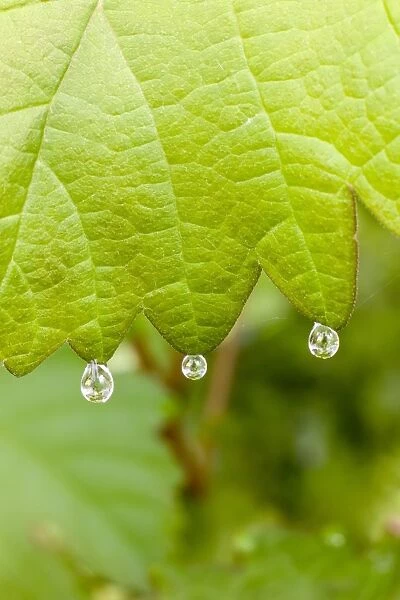Home > Animals > Mammals > Muridae > Water Mouse
Leaf of a grapevine showing guttatio C013 / 7349
![]()

Wall Art and Photo Gifts from Science Photo Library
Leaf of a grapevine showing guttatio C013 / 7349
A leaf of a grapevine (Vitis vinifera ) growing in a glasshouse, photographed just after dawn in early summer, UK.Plants obtain dissolved soil nutrients by absorbing them through their roots. During daylight, the nutrients are drawn upwards within the xylem cells of the plant, as water evaporates from the leaves via open stomatal pores on their surface (transpiration). At night, roots continue to absorb mineral ions, but the stomatal pores are closed. The ions within the xylem fluid raise its osmotic pressure, ( so-called root pressure) and water is drawn into the xylem from surrounding cells in the plant by osmosis. The excess fluid escapes through surface cells known as hydathodes, causing droplets to form at the leaf edge. On still warm mornings, guttation is the cause of dew" on plants growing n the open; on cool mornings, dew is caused by condensation of water from the air"
Science Photo Library features Science and Medical images including photos and illustrations
Media ID 9199123
© DR JEREMY BURGESS/SCIENCE PHOTO LIBRARY
Osmotic Pressure Transpiration Vitis Vinifera Xylem Grapevine Osmosis
EDITORS COMMENTS
This print captures the intricate beauty of a grapevine leaf (Vitis vinifera) in all its glory. Taken just after dawn in early summer within a glasshouse in the UK, the image showcases nature's remarkable processes at work. Plants, like this grapevine, rely on their roots to absorb dissolved soil nutrients. During daylight hours, these vital nutrients are transported upwards through xylem cells as water evaporates from the leaves via stomatal pores on their surface - a process known as transpiration. However, when night falls and stomatal pores close, roots continue to absorb mineral ions. The accumulation of these ions within the xylem fluid increases its osmotic pressure, creating what is referred to as root pressure. This phenomenon draws water into the xylem from surrounding plant cells through osmosis. As a result of this excess fluid build-up, droplets form at the edge of leaves and escape through specialized surface cells called hydathodes - giving rise to guttation. On still warm mornings such as this one captured by Dr Jeremy Burgess from Science Photo Library, guttation becomes evident and is often mistaken for dew found on plants growing outdoors. In contrast, dew forms due to condensation of water vapor present in cooler morning air. This mesmerizing photograph not only highlights nature's intricate mechanisms but also serves as a reminder of how even seemingly small details can hold immense scientific significance.
MADE IN THE USA
Safe Shipping with 30 Day Money Back Guarantee
FREE PERSONALISATION*
We are proud to offer a range of customisation features including Personalised Captions, Color Filters and Picture Zoom Tools
SECURE PAYMENTS
We happily accept a wide range of payment options so you can pay for the things you need in the way that is most convenient for you
* Options may vary by product and licensing agreement. Zoomed Pictures can be adjusted in the Cart.


